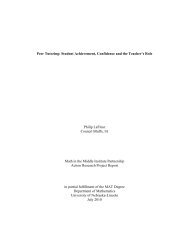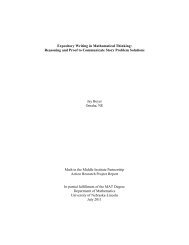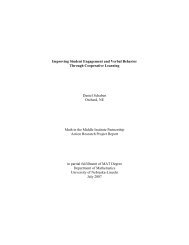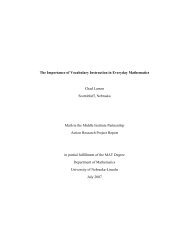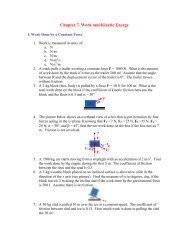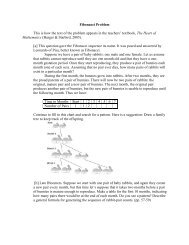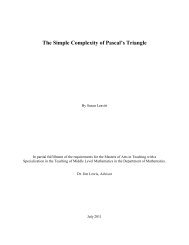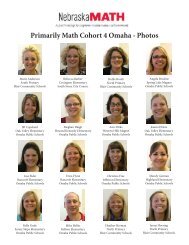2. Pascals Triangle
2. Pascals Triangle
2. Pascals Triangle
- No tags were found...
You also want an ePaper? Increase the reach of your titles
YUMPU automatically turns print PDFs into web optimized ePapers that Google loves.
QuestionofDayQuestion of the DayIn how many ways can you draw a card from a standard deck of 52? In how many ways can you draw a pairof cards from a standard deck of 52? In how many ways can you draw three cards from a deck of 52 cards?In the last two cases, assume that order does not matter. Discuss why it is safe to assume that order does notmatter.Key ConceptsKey Concepts1.<strong>2.</strong>The Generalized Principle of Counting says that if there are m ways for a first action to occur and thenthere n ways for a second action to occur, then altogether there are m . n ways for the pair of actions tooccur (in order.)Counting is hard, so it is important to look at simple cases, and apply the methods systematically tomore complex cases.VocabularyVocabulary1.is the number of combinations of S objects taken from a larger set of T objects.<strong>2.</strong>The expression or symbolis called a combination. It is also called a binomial coefficient, since it occurs in the expansion of abinomial expression.Mathematical IdeasMathematical IdeasCombinationsConsider the number of ways of selecting a subset of S things from a larger collection of T things. By theFundamental Principle of Counting, there are T ways of selecting the first thing, then T - 1 ways of selectingthe second thing, so there are T . (T - 1) ways of selecting both. Extending this idea, there are
ways of selecting the S objects. But this counts order. There areways of ordering the S objects in a row. Hence bunching or collecting the selections of S objects in groupswith the same elements in all the possible orders, we see that there isways of selecting S objects from a larger group of T objects, when the section is without regard to order.This calculation can be represented asNote the cancellation of the factors (T - S), (T - S - 1) . . . 3, 2, 1 from numerator and denominator to leavejust the expression above.This expression is so common, it is given a name and a symbol: We writeand we say that this is the number of combinations of S objects taken from a larger set of T objects. Theexpression or symbolis called a combination. It is also called a binomial coefficient, since it occurs in the expansion of a binomialexpression.The binomial coefficients occur in many places in mathematics. In particular, the entry in the S positionacross in the T row of Pascal’s <strong>Triangle</strong> is .Sample Worked ProblemsProblem 14, Oregon LottoProblem Statement: To win the jackpot of the Oregon lottery game, you must correctly pick the six numbersselected fromt he numbers 1 through 4<strong>2.</strong> What is the probability of winning the Oregon Lottery?Comment: As of March 2006, these rules do not seem to be the Oregon lottery anymore. It appears thatOregon now plays a number of games, including the closest which is the now multi-state PowerBall. ForPowerBall one must match 5 numbers drawn from a set of balls numbered 1 to 55, and a sixth PowerBalldrawn from a separate set of balls numbered 1 to 4<strong>2.</strong>
But anyway, assuming the rules above, there are 42 ways to draw the first ball, then 41 ways to draw thesecond ball, and so on, down to 42 - (6 - 1) = 37 ways to draw the sixth ball. There are 42 . 41 . 40 . 39 . 38 .37 = 3776965920 ways of drawing the 6 numbers. However, the order of drawing the balls does not matter,only the numbers themselves (which are usually displayed in increasing order for convenience in matching.)Given a set of 6 distinct numbers there would be 6! = 720 ways of ordering them. Each of these ways wouldbe enumerated in the ordered listing, but all would be equivalent in the rules of the lottery. Hence, we mustdivide 3776965920/720 = 5245786 to get the number of equivalent drawings. Only one of these would matchour pick of six numbers, so the chance of winning the lottery in these rules is 1/5245786, that is, less than onein 5 million!Problem 33, Car CareProblem Statement: A burglar wishes to break into a car that has a security system. There are 5 buttonsmarked 1 through 5 to disarm he system and he knows the code is a three-digit number. How many possiblesecurity codes are there? Knowing this number of combinations, the burglar fears that he will enter the wrongnumber first - thus tripping the alarm (which everyone just ignores). SO he writes down his first 20 guessesand then enters his next guess. Does this strategy improve his chances of success?Solutions: We must make an assumption that numbers in the security code may be repeated and we maysafely assume that order counts. Thus, 123 is a possible security code and 321, 231 and 132 are all distinctpossible security codes. Likewise, 555 is also a possible security code. There are 5 choices for the first codenumber, then 5 choices for the second code number for a possible total of 5 . 5 choices for the first twonumbers. Then there are 5 more choices for the third code number for a total of 5 . 5 . 5 = 125 possible codes.The burglar’s strategy does not pay off in increased chances of disarming the system. Using the 21st guessafter abandoning the first twenty guesses is no better than using the first guess. Another way of saying it is theguesses are independent, and so each new guess starts the process over, without altering the probability ofsuccess at any stage.Problem 30, Making up the TestProblem Statement: Your math prof says there will be a 15-question test on probability. She also reports thatthe test will be made up of problems from the Problem Sets of the Chapter as follows: two questions eachfrom Sections 7.2, 7.3, and 7.7 (with 40, 40 and 35 questions each.) and three questions each from 7.4, 7.5,7.6 (with 40, 22, and 35 questions each.)Solutions: Then there will bepossible tests.Problems to Work for Understanding1.<strong>2.</strong>3.Solidifying Ideas: pages 566: 11,12,13,23,25New Ideas: page 568: 31, 32Habits of Mind: page 569: 36
Reading Suggestion:1. <strong>2.</strong>Last modified:



